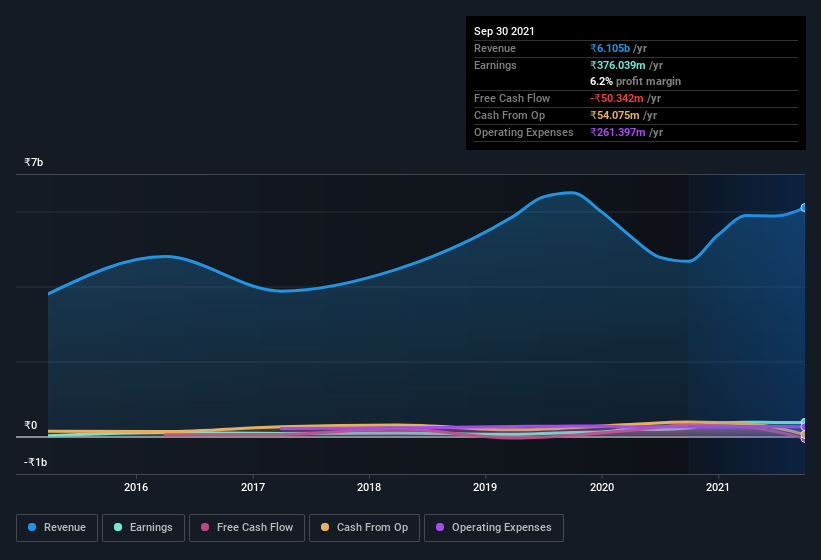Kriti Industries (India) (NSE:KRITI) Posted Healthy Earnings But There Are Some Other Factors To Be Aware Of

Kriti Industries (India) Limited's (NSE:KRITI) robust earnings report didn't manage to move the market for its stock. We did some digging, and we found some concerning factors in the details.
See our latest analysis for Kriti Industries (India)

Zooming In On Kriti Industries (India)'s Earnings
As finance nerds would already know, the accrual ratio from cashflow is a key measure for assessing how well a company's free cash flow (FCF) matches its profit. To get the accrual ratio we first subtract FCF from profit for a period, and then divide that number by the average operating assets for the period. This ratio tells us how much of a company's profit is not backed by free cashflow.
As a result, a negative accrual ratio is a positive for the company, and a positive accrual ratio is a negative. That is not intended to imply we should worry about a positive accrual ratio, but it's worth noting where the accrual ratio is rather high. Notably, there is some academic evidence that suggests that a high accrual ratio is a bad sign for near-term profits, generally speaking.
For the year to September 2021, Kriti Industries (India) had an accrual ratio of 0.24. Therefore, we know that it's free cashflow was significantly lower than its statutory profit, which is hardly a good thing. Even though it reported a profit of ₹376.0m, a look at free cash flow indicates it actually burnt through ₹50m in the last year. It's worth noting that Kriti Industries (India) generated positive FCF of ₹310m a year ago, so at least they've done it in the past. The good news for shareholders is that Kriti Industries (India)'s accrual ratio was much better last year, so this year's poor reading might simply be a case of a short term mismatch between profit and FCF. As a result, some shareholders may be looking for stronger cash conversion in the current year.
Note: we always recommend investors check balance sheet strength. Click here to be taken to our balance sheet analysis of Kriti Industries (India).
Our Take On Kriti Industries (India)'s Profit Performance
Kriti Industries (India) didn't convert much of its profit to free cash flow in the last year, which some investors may consider rather suboptimal. Because of this, we think that it may be that Kriti Industries (India)'s statutory profits are better than its underlying earnings power. But the good news is that its EPS growth over the last three years has been very impressive. At the end of the day, it's essential to consider more than just the factors above, if you want to understand the company properly. If you want to do dive deeper into Kriti Industries (India), you'd also look into what risks it is currently facing. Be aware that Kriti Industries (India) is showing 3 warning signs in our investment analysis and 2 of those can't be ignored...
Today we've zoomed in on a single data point to better understand the nature of Kriti Industries (India)'s profit. But there is always more to discover if you are capable of focussing your mind on minutiae. For example, many people consider a high return on equity as an indication of favorable business economics, while others like to 'follow the money' and search out stocks that insiders are buying. So you may wish to see this free collection of companies boasting high return on equity, or this list of stocks that insiders are buying.
Valuation is complex, but we're here to simplify it.
Discover if Kriti Industries (India) might be undervalued or overvalued with our detailed analysis, featuring fair value estimates, potential risks, dividends, insider trades, and its financial condition.
Access Free AnalysisThis article by Simply Wall St is general in nature. We provide commentary based on historical data and analyst forecasts only using an unbiased methodology and our articles are not intended to be financial advice. It does not constitute a recommendation to buy or sell any stock, and does not take account of your objectives, or your financial situation. We aim to bring you long-term focused analysis driven by fundamental data. Note that our analysis may not factor in the latest price-sensitive company announcements or qualitative material. Simply Wall St has no position in any stocks mentioned.
Have feedback on this article? Concerned about the content? Get in touch with us directly. Alternatively, email editorial-team (at) simplywallst.com.
About NSEI:KRITI
Kriti Industries (India)
Manufactures and sells plastic products and pipes in India and internationally.
Excellent balance sheet second-rate dividend payer.
Similar Companies
Market Insights
Community Narratives




